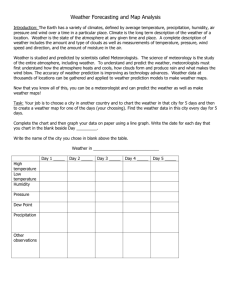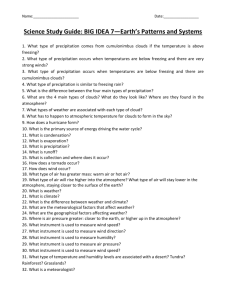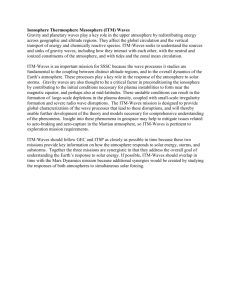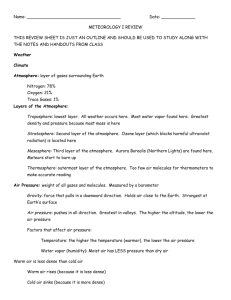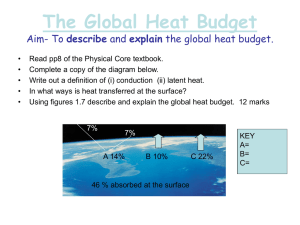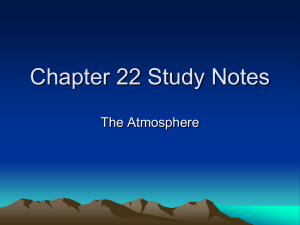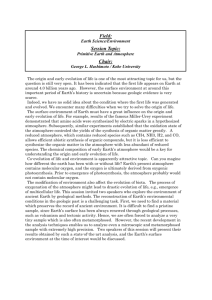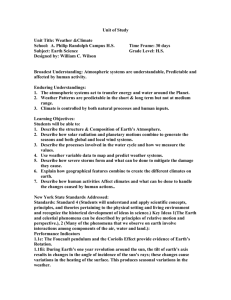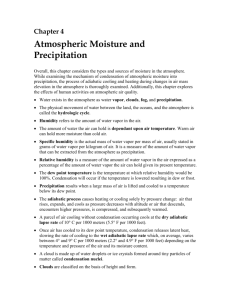Unit Test: Atmospheric Forces
advertisement
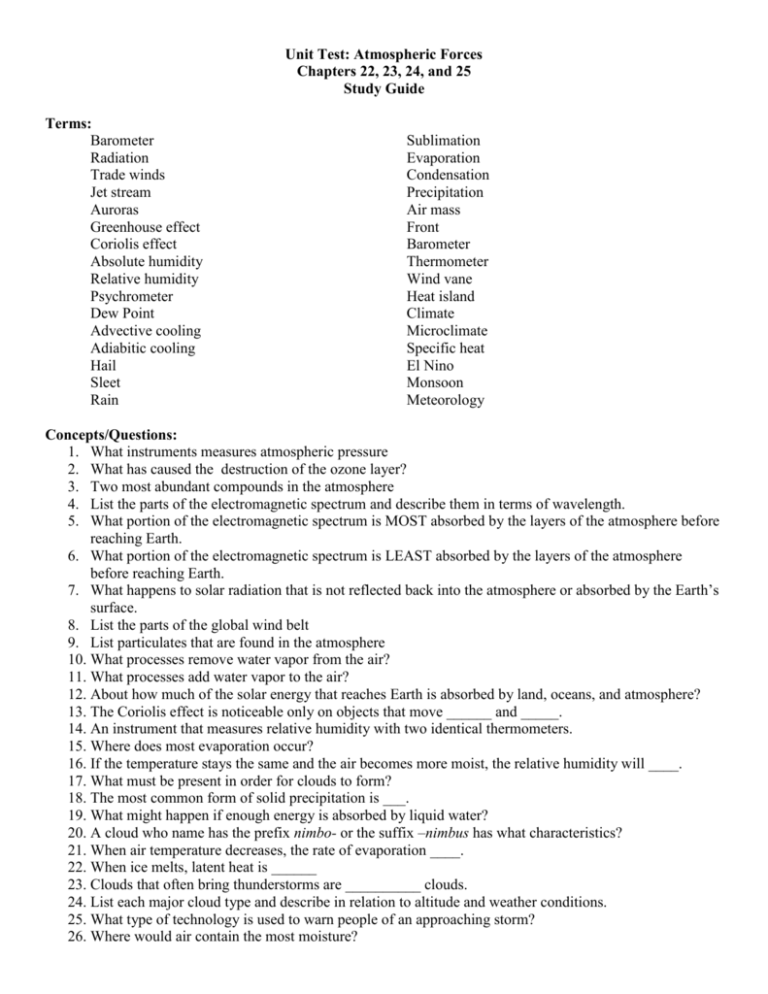
Unit Test: Atmospheric Forces Chapters 22, 23, 24, and 25 Study Guide Terms: Barometer Radiation Trade winds Jet stream Auroras Greenhouse effect Coriolis effect Absolute humidity Relative humidity Psychrometer Dew Point Advective cooling Adiabitic cooling Hail Sleet Rain Sublimation Evaporation Condensation Precipitation Air mass Front Barometer Thermometer Wind vane Heat island Climate Microclimate Specific heat El Nino Monsoon Meteorology Concepts/Questions: 1. What instruments measures atmospheric pressure 2. What has caused the destruction of the ozone layer? 3. Two most abundant compounds in the atmosphere 4. List the parts of the electromagnetic spectrum and describe them in terms of wavelength. 5. What portion of the electromagnetic spectrum is MOST absorbed by the layers of the atmosphere before reaching Earth. 6. What portion of the electromagnetic spectrum is LEAST absorbed by the layers of the atmosphere before reaching Earth. 7. What happens to solar radiation that is not reflected back into the atmosphere or absorbed by the Earth’s surface. 8. List the parts of the global wind belt 9. List particulates that are found in the atmosphere 10. What processes remove water vapor from the air? 11. What processes add water vapor to the air? 12. About how much of the solar energy that reaches Earth is absorbed by land, oceans, and atmosphere? 13. The Coriolis effect is noticeable only on objects that move ______ and _____. 14. An instrument that measures relative humidity with two identical thermometers. 15. Where does most evaporation occur? 16. If the temperature stays the same and the air becomes more moist, the relative humidity will ____. 17. What must be present in order for clouds to form? 18. The most common form of solid precipitation is ___. 19. What might happen if enough energy is absorbed by liquid water? 20. A cloud who name has the prefix nimbo- or the suffix –nimbus has what characteristics? 21. When air temperature decreases, the rate of evaporation ____. 22. When ice melts, latent heat is ______ 23. Clouds that often bring thunderstorms are __________ clouds. 24. List each major cloud type and describe in relation to altitude and weather conditions. 25. What type of technology is used to warn people of an approaching storm? 26. Where would air contain the most moisture? 27. What happens to air as it warms? 28. An air mass usually brings the weather of its ______. 29. Name the four types of air masses and describe each in relation to weather conditions. 30. Doppler radar and satellite images provide information that is used to create ___. 31. Weather symbols H and L indicate ______. 32. How do scientists convey information on a weather map? 33. List the types of fronts and the weather associated with each. 34. What affects the angle at which the sun’s rays hit the Earth? 35. What weather effect results when a moving air mass hits a mountain, rises, cools, and loses most of its moisture through precipitation? 36. What are the two major factors used to identify climate? 37. List and describe the major climate zones. 38. What geological feature moderates temperature and increases rainfall? 39. What is affected by climate change? 40. What actions will help reduce CO2 levels in the atmosphere? 41. What actions will help increase CO2 levels in the atmosphere? 42. Clues about animal adaptations to climate change have been found in the study of ____. 43. Average land and water temperatures at the same latitude vary because of differences in heat loss through ___. 44. What differences exist when the sun heats water and land? 45. What method of studying past climates has been used to measure the longest length of time? 46. What evidence shows that ice ages follow decreases in the global level of CO2? 47. How do pavement and buildings in cities affect the local climate? 48. What happens when an air mass encounters a mountain range? 49. What do high levels of carbon dioxide in an ice core indicate? 50. What do fossils of flower pollen and plants with broad leaves indicate? 51. What weather condition do tropical desert and polar icecap climates have in common? 52. By how much has the global temperatures increased over the last 100 years? 53. What is the most abundant element in air? 54. What keeps 99% of the total mass of the atmosphere within 32km of Earth’s surface? 55. How do ocean and land surfaces help heat the atmosphere? 56. Compare the processes of conduction and convection. 57. An air mass moves from the Gulf of Mexico over the southern United States, where temperatures are colder. Clouds form over the southern United States. What type of cooling caused the cloud formation? 58. How is relative humidity related to the dew point? 59. What phase change occurs in the formation of frost? 60. Why does dew often form at night? 61. Explain how knowledge of the global wind belts might have helped a sixteenth-century explorer sailing from Spain to the northern part of South America? 62. An architect plans to use solar energy to heat the next home she designs. What principles of absorption and infrared energy can be applied to the design of the new home? How might she apply those principles? 63. You see lumps of ice the size of golf balls falling from the sky. What form of precipitation are you seeing? How did it form? 64. Name a major factor that influences climate, and explain its significance. 65. Describe how latitude determines the amount of solar energy that reaches Earth. 66. Explain why, on a typical summer day, the air over the Great Lakes cooler than the air over the shore and nearby land? 67. Explain how a rain shadow forms?
